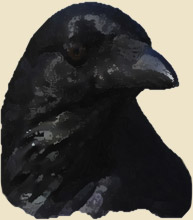Social Behavior & Disease

 We are currently exploring links between land-use, disease, and social behavior in wild birds. Our work has two primary foci: disease ecology and behavioral ecology.
We are currently exploring links between land-use, disease, and social behavior in wild birds. Our work has two primary foci: disease ecology and behavioral ecology.
Disease Ecology
Our work, both in the Sacramento Valley of California and in upstate New York, has shown that synanthropic American Crows suffer from a wide breadth of viral, bacterial, and fungal diseases. In the Sacramento Valley, disease appears to be driving a large-scale die-off of crows in both the urban and agricultural landscapes: only 4% of young crows produced in 2012 are still alive six months after hatching, and many of those show signs of severe disease. West Nile virus, a recently emerged infectious disease to which corvids are highly susceptible, appears to be responsible for only a small fraction of this die-off. We are currently examining the myriad pathogens affecting these birds and exploring features of urban and agricultural landscapes that contribute to disease risk. Some of our specific questions include:
•How do features of human-dominated landscapes affect disease prevalence and survival probability of corvids (crows, magpies, and jays)?
•Do pollutants (e.g., anticoagulant pesticides) contribute to disease risk?
•Are corvids responsible for the transfer of human pathogens (e.g., Campylobacter, antibiotic-resistant bacteria, West Nile virus) across the landscape? We are addressing this question on both a local (California) and global scale.
Much of diagnostic work is carried out in collaboration with a team of researchers in the UC Davis School of Veterinary Medicine and the Center for Wildlife Health.
Behavioral Ecology
Corvids like American Crows and Yellow-billed Magpies are highly social. American Crows breed in family groups of up to 15 birds and often roost and forage in large numbers (>20,000 birds). The California endemic Yellow-billed Magpies are colonial nesters of conservation concern because of their narrow geographic range. Both species suffer high prevalence of infectious diseases, which is probably related to their social structure. We are exploring the interactions between disease, genetics, environment, and social behavior in this system.
Specifically, we seek to address the following questions:
•Should individuals help sick family members, or avoid them?
•How do inbreeding and other genetic factors interact with urbanization to affect disease risk?
•Will the emergence of new disease pressures drive rapid evolution of social behavior?
Read on for details of some of our previous work with the American Crow.
Inbreeding is surprisingly common in crows. Our work showed that approximately 20% of offspring in one urban population of crows in Ithaca, NY were produced by mother-son or uncle-niece matings (Townsend et al. (2009) An. Beh.). The costs of inbreeding were high. We found that inbred offspring were in poor condition, mounted a suppressed innate immune response (Townsend et. al. (2010) Proc. R. Soc. B.), and had a lower survival probability (Townsend et al. (2009) Proc. R. Soc. B.) than their outbred counterparts. Lower survival probability appeared to be mediated, at least in part, by higher disease probability of inbred birds (Townsend et al. (2009) Proc R Soc B). In addition to West Nile virus, we found that crows were susceptible to a suite of other viral, fungal, bacterial, and parasitic infections (Miller et. al. (2010) J. Vet. Diagn. Invest).
Extrapair paternity (a.k.a. “cuckoldry,” or fertilizations by males outside of the bonds of socially monogamous pairs) is one possible tool that female crows could use to reduce the incidence of inbreeding in their brood. If, for example, females are socially paired to male relatives, they might seek extrapair fertilizations from less-related males. This mechanism of inbreeding avoidance does not appear to occur in crows, however. We found no evidence that females were less related to extrapair males than to their social pair males, no evidence that prospective extrapair males were more successful when they were less related to a given female (Townsend (2009) Condor), and no evidence of any genetic benefits at all gained by females through extrapair paternity (Townsend et al. (2010) Am. Nat.). Females did, however, seem to gain some direct benefits, because the provisioning rate and brood output was higher when extrapair males were “helpers” within the group (Townsend et al. (2010) Am. Nat.). It is still debatable (to AKT, anyway!) whether or not female “choose” to be fertilized by extrapair males, or if extrapair males force female crows to copulate.
Currently, I am examining how urbanization is altering (and, perhaps, elevating) inbreeding depression in two urban-commensal species: the American Crow and the Yellow-billed Magpie. In collaboration with Walter Boyce (UC Davis School of Veterinary Medicine; Wildlife Health Center), Sarah Wheeler, and Bill Reisen (both from the UC Davis Center for Vectorborne Diseases), and others, we are looking at how the nature and prevalence of disease varies across and urban to rural/ agricultural gradient.
I am also examining range-wide patterns of inbreeding and inbreeding depression, using optimization modeling to examine the balance between inbreeding depression and kin selection, and assessing the role of a novel immunosuppressive virus in elevating disease prevalence.
